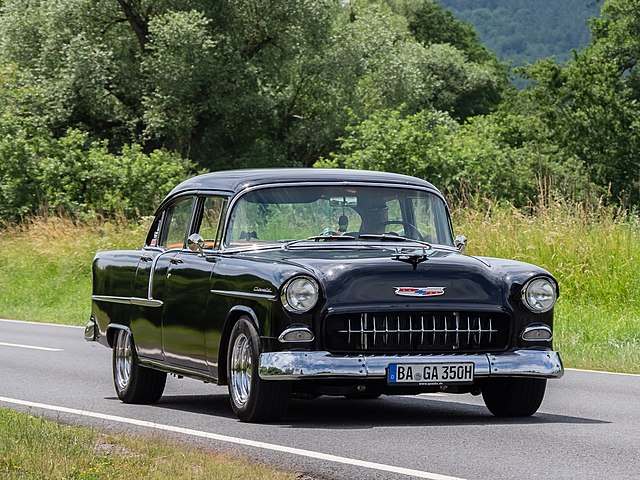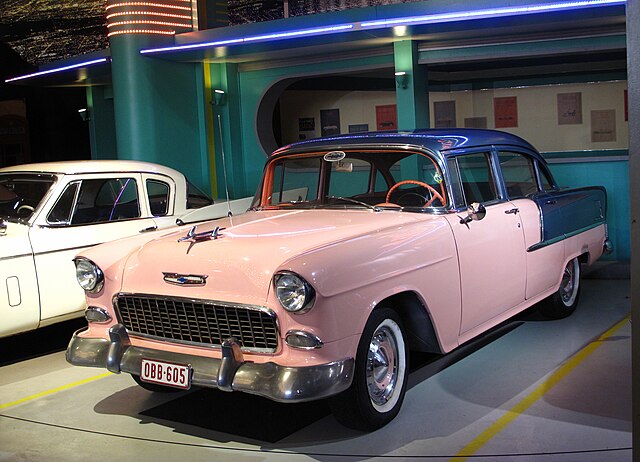
The Chevrolet Bel-Air, particularly its second generation spanning from 1955 to 1957, stands as one of the most iconic and revolutionary models in the history of automobiles. This period marked a significant transformation in design, engineering, and consumer appeal, propelling the Chevrolet brand into a new era of automotive excellence.
The Bel-Air became synonymous with mid-century American culture, representing both luxury and the accessibility of the American dream.
Design and Styling Evolution

Exterior Aesthetics
The second-generation Chevrolet Bel-Air introduced a sharper, more distinguished look compared to its predecessors. The body featured clean lines and an integrated fender design, moving away from the bulkier look of the early 1950s.
Notably, the 1957 model introduced more pronounced tailfins, which became a hallmark of the era’s automotive design. These changes not only enhanced the vehicle’s visual appeal but also improved its aerodynamic efficiency.
Interior Innovations
Inside, the Bel-Air boasted a redesigned dashboard and more spacious interiors, which were considered cutting-edge at the time. The use of chrome and color-coordinated interiors elevated the overall feel of luxury.
The attention to detail extended to the upholstery, with options such as two-tone color schemes and premium materials, reflecting the consumer’s growing interest in both comfort and style.
Technological Enhancements
Technological advancements were also part of the design evolution. The introduction of the two-speed Powerglide automatic transmission in these models offered a smoother ride and better handling.
Additionally, improvements in heating and ventilation systems marked significant strides in passenger comfort, a key selling point during this era.
Performance and Powertrain

Engine Options
The second generation of the Bel-Air saw significant upgrades in performance, most notably through the introduction of the small-block V8 engine in 1955. This engine quickly gained fame for its reliability and considerable power output.
Throughout these years, Chevrolet offered a range of engines including a six-cylinder model and multiple V8 configurations, catering to various performance needs and budgets.
Transmission and Handling
Alongside engine improvements, Chevrolet enhanced the Bel-Air’s transmission options. The availability of both manual and automatic transmissions, including the aforementioned Powerglide, allowed drivers to choose based on their driving preference. Improved suspension designs contributed to a smoother and more stable ride, even at higher speeds.
Performance Legacy
The performance enhancements of the Bel-Air not only improved its market competitiveness but also laid the groundwork for Chevrolet’s future success in the performance car segment. This era of the Bel-Air is often credited with initiating the muscle car era that took full swing in the 1960s.
Cultural Impact and Legacy

Symbol of the Era
The Chevrolet Bel-Air became more than just a car; it was a cultural icon that encapsulated the optimism of the post-war era. Its affordable luxury made it accessible to a broad segment of the American population, symbolizing prosperity and the attainable American dream.
Influence in Media
The Bel-Air’s distinctive design and cultural significance made it a popular choice in films, television, and music, reinforcing its status as an emblem of the 1950s. It has been featured in numerous works of pop culture, often associated with themes of nostalgia and Americana.
Collector’s Favorite
Today, the second-generation Bel-Air is a favorite among classic car collectors. Its design, historical significance, and the nostalgic value it holds continue to make it a sought-after model in classic car shows and auctions around the world.
Technological Innovations and Safety Features
Safety Enhancements
While safety standards in the 1950s were not what they are today, the Bel-Air included features like improved braking systems and, in later years, options for seat belts—a rare feature at the time.
Technological Firsts
The Bel-Air also featured technological firsts such as electric clocks, signal-seeking radios, and power steering, which were considered luxury features. These innovations highlighted Chevrolet’s commitment to integrating technology that enhanced driver experience and convenience.
Impact on Automotive Engineering
The technological strides made with the Bel-Air influenced the entire automotive industry. Chevrolet’s focus on integrating new technologies set a standard for what was expected in everyday passenger vehicles and pushed competitors to also innovate.
Conclusion: The Lasting Influence of the Bel-Air
The second-generation Chevrolet Bel-Air not only defined an era but also helped shape the future of the automotive industry. Its blend of style, performance, and affordability made it an enduring favorite, influencing subsequent designs and maintaining a beloved status among enthusiasts.
The legacy of the Bel-Air continues to be celebrated, a testament to its impact and lasting appeal in the pantheon of classic American cars.
